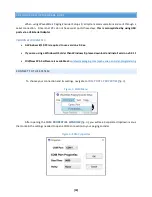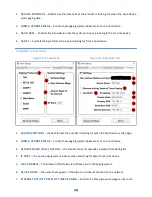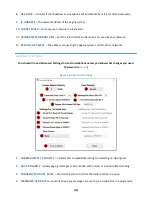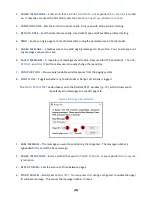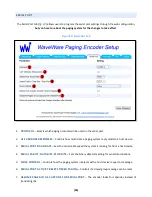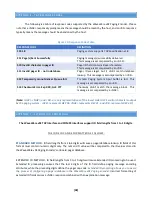
[23]
1.
FAMILY
– A row designation for each Pager Family.
2.
ENABLE
– Controls if a Pager Family is checked when paging data is received from a
HOST DEVICE
.
3.
PAGER QTY
– Sets the range of ID and capcode pairings. It can be set from
1-999
.
4.
START ID
– Sets the first ID used in order to calculate the range. Valid IDs range from
1-9999
.
5.
END ID
– An unmodifiable display of the last calculated ID in the range.
6.
START CAPCODE
– Sets the first capcode used in order to calculate the range.
7.
END CAPCODE
– An unmodifiable display of the last calculated capcode in the range.
8.
PAGER TYPE
– Changes the message type pagers receive from this Pager Family.
9.
FUNCTION CODE
– Sets the function code used by a pager when it receives a page from this Pager
Family. Some pagers refer to function codes as digits or letters instead of binary memory values. In this
case:
00 = 0 = A, 01 = 1 = B, 10 = 2 = C
,
and
11 = 3 = D
.
10.
DATA RATE
– Sets the transmission rate in this Pager Family. Choices are:
512, 1200,
and
2400
.
11.
PREFIX
– Adds a prepended message from
PREDEFINED MSGS
to pages from this Pager Family
.
12.
SUFFIX
– Adds an appended message from
PREDEFINED MSGS
to pages from this Pager Family.
13.
CLEAR ALL
– Resets all Pager Families to default values.
14.
SORT BY START ID
– Changes which row a Pager Family belongs to, based on ascending ID digit order.
15.
INCREMENT CAPCODES BY 8
- Changes whether the capcodes number sequentially or by 8 for each
ID.
16.
SORT BY START CAPCODE
- Changes which row a Pager Family belongs to, based on ascending capcode
digit order.
17.
SAVE CHANGES
– Writes the current state of the Pager Families configuration to the paging encoder. If
you switch tabs before saving, all changes will be lost.


